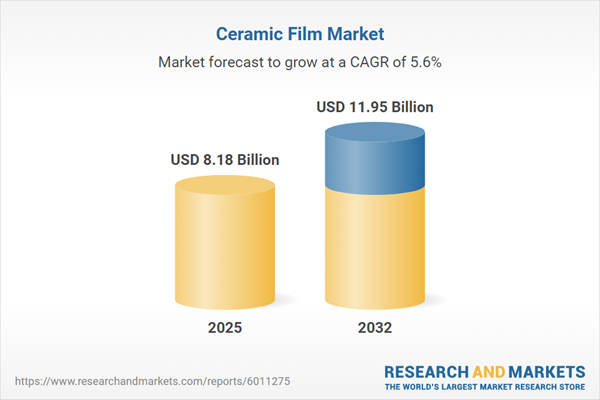Speak directly to the analyst to clarify any post sales queries you may have.
The ceramic film market is evolving as a cornerstone for innovation across industries, powering enhanced durability, thermal management, and new aesthetic solutions. Senior decision-makers seeking strategic insights into growth factors, competitive positioning, and technology trends will find this analysis relevant for future planning and investment.
Market Snapshot: Ceramic Film Market Growth and Outlook
The ceramic film market grew from USD 7.74 billion in 2024 to USD 8.18 billion in 2025 and is projected to expand at a CAGR of 5.57%, achieving USD 11.95 billion by 2032. This trajectory underscores expanding applications in sectors requiring advanced coatings for environmental protection, aesthetics, and functional performance. Increasing demand in aerospace, automotive, construction, electronics, and medical device manufacturing continues to underpin this robust outlook.
Ceramic Film Market Scope & Segmentation
This report provides a comprehensive analysis of the ceramic film market, covering major segments by application, end user industry, film type, technology, substrate, function, distribution channel, and thickness, as well as key geographies. Strategic segmentation enables targeted insights for decision-makers considering market entry, portfolio expansion, or technology investments.
- Applications: Decorative coating, insulating coating, optical coating, protective coating
- Decorative Coating Types: Color coating, patterned coating
- Insulating Coating Types: Electrical insulation, thermal insulation
- Optical Coating Options: Anti-glare, anti-reflective, filter
- Protective Coating Functions: Anti-scratch, corrosion-resistant, wear-resistant
- End User Industries: Aerospace (commercial, military), automotive (OEM, aftermarket), construction (commercial, residential), electronics (consumer electronics, semiconductors, telecommunications), medical (devices, equipment)
- Film Types: Monolayer, multilayer (dual layer, triple layer)
- Technologies: CVD (LPCVD, PECVD), PVD
- Substrates: Glass, metal, plastic (PC, PET, PMMA)
- Functions: Anti-corrosion, anti-reflective, scratch resistance, thermal barrier
- Distribution Channels: Direct sales, distributor, online
- Thickness Options: Greater than 5 micrometers, less than 1 micrometer, one to five micrometers
- Geographic Regions: Americas (United States, Canada, Mexico, Brazil, Argentina, Chile, Colombia, Peru), Europe, Middle East & Africa (United Kingdom, Germany, France, Russia, Italy, Spain, Netherlands, Sweden, Poland, Switzerland, United Arab Emirates, Saudi Arabia, Qatar, Turkey, Israel, South Africa, Nigeria, Egypt, Kenya), Asia-Pacific (China, India, Japan, Australia, South Korea, Indonesia, Thailand, Malaysia, Singapore, Taiwan)
- Key Companies Profiled: 3M Company, Eastman Chemical Company, Saint-Gobain, Avery Dennison Corporation, PPG Industries, Nanofilm Technologies International, V-KOOL Group, Madico, Hanita Coatings, Ceramic Pro USA
Key Takeaways: Strategic Insights for Stakeholders
- Expanding multifunctional film demand is driving convergence of durability, optical, and decorative properties in both established and emerging end-use sectors.
- Advancements in deposition technology, particularly CVD and PVD, enable precise control over thickness and uniformity, improving product performance for challenging applications.
- The adoption of sustainable coating processes, including low-temperature and solvent-free methods, is gaining traction due to tightened environmental regulations and customer preferences.
- Rising collaboration among material scientists, equipment providers, and system integrators accelerates the development of new coating architectures and hybrid applications.
- Regional differences are shaping the pace and focus of adoption, with Asia-Pacific leading in volume and technology transfer, and North America and EMEA emphasizing energy efficiency and sustainability.
Tariff Impact: Navigating Policy and Supply Chain Shifts
Recent tariff adjustments in the United States have increased import duties on key materials, prompting shifts in supplier strategies and the establishment of regional manufacturing hubs. These changes influence pricing negotiations across the value chain and encourage joint development of alternative, locally sourced film precursors. Enhanced supply chain agility is crucial in mitigating exposure to policy fluctuations, with many distributors broadening their service offerings to strengthen customer retention during margin pressures.
Methodology & Data Sources
The report leverages a hybrid research approach that integrates secondary sources such as technical literature, corporate filings, and regulatory documents with primary data collection from industry leaders. Trade flow and tariff datasets further inform the supply chain and policy impact analysis.
Why This Report Matters
- Enables strategic planning by detailing actionable segmentation and disruptive technology trends in the ceramic film market.
- Equips executives to anticipate supply chain shifts and regulatory changes affecting global and regional growth strategies.
- Facilitates informed decisions on product development, partnership opportunities, and risk mitigation in key industry sectors.
Conclusion
The ceramic film market is characterized by dynamic innovation and shifting regional trends. Informed decision-making, agile adaptation, and collaborative approaches will be crucial for capturing new opportunities and sustaining competitive advantage.
Additional Product Information:
- Purchase of this report includes 1 year online access with quarterly updates.
- This report can be updated on request. Please contact our Customer Experience team using the Ask a Question widget on our website.
Table of Contents
3. Executive Summary
4. Market Overview
7. Cumulative Impact of Artificial Intelligence 2025
Companies Mentioned
The companies profiled in this Ceramic Film market report include:- 3M Company
- Eastman Chemical Company
- Saint-Gobain
- Avery Dennison Corporation
- PPG Industries, Inc.
- Nanofilm Technologies International Limited
- V-KOOL Group Co., Ltd.
- Madico, Inc.
- Hanita Coatings Ltd.
- Ceramic Pro USA, LLC
Table Information
| Report Attribute | Details |
|---|---|
| No. of Pages | 187 |
| Published | November 2025 |
| Forecast Period | 2025 - 2032 |
| Estimated Market Value ( USD | $ 8.18 Billion |
| Forecasted Market Value ( USD | $ 11.95 Billion |
| Compound Annual Growth Rate | 5.5% |
| Regions Covered | Global |
| No. of Companies Mentioned | 11 |









